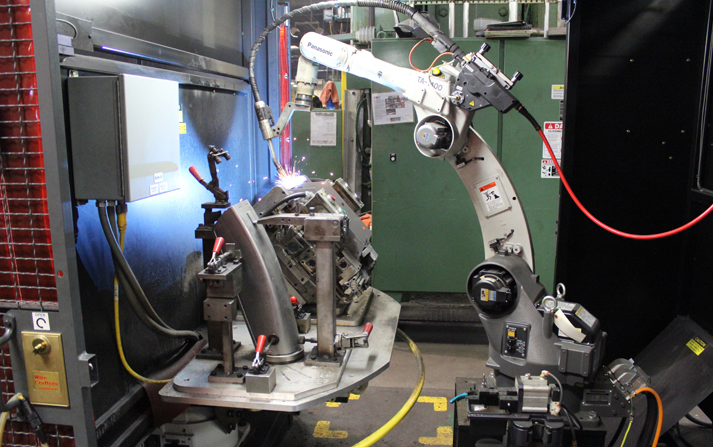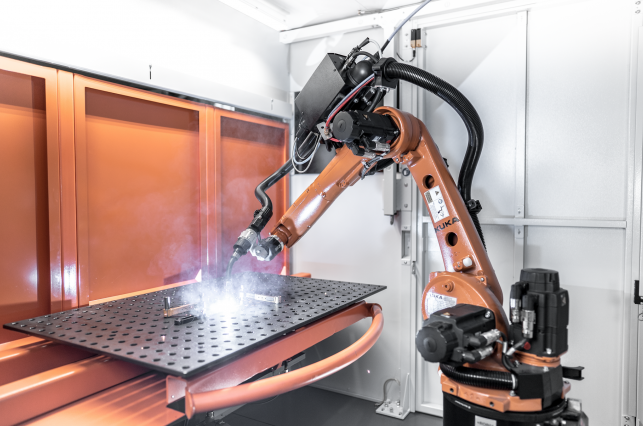Technical Complexities
Precision and Accuracy Requirements
Robotic welding systems demand high precision and accuracy to ensure strong and reliable welds. Manufacturers must calibrate robots meticulously to work within tight tolerances, often less than a millimeter. This accuracy is crucial for tasks such as automotive assembly, where the structural integrity of a vehicle depends on the quality of the welds. Every robot arm must follow the programmed path with minimal deviation to maintain the welding quality across different runs and workpieces.
Programming and Integration Difficulties
Programming robotic welders involves defining complex instructions and paths that the machine will follow. Each project might require hundreds of hours of programming by skilled technicians. Integration also poses a challenge; welding robots must work in harmony with existing systems and machinery. For instance, in a production line, the welder must sync with conveyors and other robotic arms to maintain an output speed of, say, 50 units per hour. This synchronization ensures efficiency and reduces the risk of production bottlenecks.

In terms of costs, the initial programming and setup can represent a significant portion of the overall investment. For a mid-sized manufacturing unit, the setup might run into tens of thousands of dollars, depending on the complexity and number of robots employed. The expense is justified by the expected improvements in efficiency and the reduction of human error over time.
The specifications for robotic welding systems vary, but a standard industrial robot arm might have six axes of movement, allowing it to approach the work from virtually any angle. The lifespan of these robots typically ranges from 8 to 12 years, depending on usage intensity and maintenance. The age of the system can impact its precision and the frequency of required maintenance. An older system may slow down production times and increase the risk of downtime, affecting the overall value of the robotic welding operation.
Manufacturers must consider these details to maintain the balance between performance and costs, ensuring that the investment in robotic welding technology delivers the desired returns without compromising the quality of the work.
Material Handling Issues
Compatibility with Various Materials
Robotic welding systems work with a plethora of materials, each presenting unique challenges. For example, welding aluminum requires different settings and equipment than welding steel does. Aluminum conducts heat quickly and requires a robot to operate at a higher speed to avoid burning through the material. Stainless steel, on the other hand, might need a slower pace to prevent warping due to its different thermal conductivity.
Each material also comes with its own specifications for optimal welding. A robotic system might need to weld metals as thin as 0.5 mm or as thick as 12 mm, necessitating adjustments in the robot’s power output. A robot that can weld a wide range of materials must support quick changeovers. This versatility could involve automatic tool changing mechanisms, which add to the system’s complexity and costs. A robotic welding setup that handles diverse materials can cost upwards of $100,000, factoring in the various welding heads and tools needed.
Ensuring Consistent Material Quality
To maintain high-quality welds, robots require materials with consistent properties. Fluctuations in material quality can lead to defects in welds, such as porosity or lack of fusion. Ensuring quality involves rigorous testing of input materials; for instance, steel batches might undergo tensile strength tests to confirm uniformity.
In terms of material handling, robots often feed from large coils of wire or sheets of metal. The consistency in the dimensions and quality of these feeds is critical. A variation in wire diameter of just 0.1 mm can disrupt the welding process, leading to downtime and rework. Maintaining consistent speed during the feed is also essential. An advanced robotic welder can handle wire feed speeds up to 20 meters per minute, but this demands precision equipment with an error margin of less than 1%.
Quality control can represent a significant portion of the material handling budget. For high-volume production, manufacturers might spend thousands of dollars monthly on testing and quality assurance measures alone. This cost is a necessary investment to mitigate the risk of welding faults that could compromise the final product’s structural integrity.
Maintenance and Upkeep
Routine Maintenance Needs
Robotic welding systems require regular maintenance to perform optimally. Technicians must lubricate moving parts, replace worn-out components, and update software. For instance, a welding robot’s joints may need greasing every 500 hours of operation to ensure smooth movement. Replacing a welding tip before it fails is crucial and typically happens after approximately 8 hours of arc time, though this can vary based on the welding intensity and materials used.
Manufacturers should also regularly calibrate sensors and check the robotic arm’s alignment. An uncalibrated robot can lead to defects in welding, causing significant setbacks. For a robotic system with a speed of 60 inches per minute, even a small deviation can result in a weld being millimeters off-position, which in high-precision tasks, is unacceptable. The cost of routine maintenance varies but can represent up to 3% of the initial purchase price annually, which for a $150,000 system equates to $4,500 yearly.
Addressing Unexpected Breakdowns
Despite preventative maintenance, robots can still break down unexpectedly. Operators must act quickly to diagnose and resolve issues to minimize downtime. A sudden failure in the welding power supply, for example, can halt production immediately. It may take several hours to a day to repair such a failure, with potential costs running into thousands of dollars in lost productivity.
Spare parts inventory is a critical aspect of minimizing downtime during unexpected breakdowns. A facility might keep an inventory valued at 5-10% of the robot’s cost to have essential components on hand, which for a $200,000 robot could mean a spare parts budget of $10,000 to $20,000. The goal is to replace a faulty part, like a servo motor that controls the robot’s precise movements, which might cost around $2,000, within the shortest time frame possible, ideally less than the turnaround time for a part’s delivery, ensuring that the robot returns to operational status swiftly.
Safety and Compliance Standards
Worker Safety Concerns
Robotic welding involves significant safety concerns for workers. Manufacturers must equip robots with safety features such as emergency stop buttons, which need checking every month to ensure functionality. Sensors that detect human presence and shut down the robot to prevent accidents are also essential. These safety measures are not just add-ons but integral to the design, and testing them might cost about $1,000 per robot for an annual safety audit.
Operators must wear appropriate personal protective equipment (PPE) like helmets with visors that can withstand high-intensity welding arcs and gloves that can resist heat and splatter. The cost of equipping a worker with complete PPE can be around $150, ensuring that safety is never compromised due to budget constraints.
Regulatory Compliance Challenges
Robotic welding systems must comply with numerous local and international safety standards. In the United States, the Occupational Safety and Health Administration (OSHA) sets guidelines for robotic equipment, including proper guarding and sufficient warning systems. Compliance with these standards may involve regular inspections and upgrades to existing systems, which can cost manufacturers thousands of dollars annually.
Manufacturers also need to adhere to environmental regulations related to welding, such as the proper ventilation to extract harmful fumes. Installing a compliant ventilation system can be a significant expense, potentially reaching $10,000 to $50,000, depending on the facility’s size and the complexity of the installation. Continuous monitoring of air quality and proper maintenance of filtration systems ensure that welding fumes stay within safe limits, safeguarding both worker health and regulatory compliance.
Economic and Productivity Considerations
Initial Investment Costs
The cost of setting up a robotic welding system extends beyond purchasing the robot. It includes peripherals like welding guns, positioners, and safety equipment. An entry-level welding robot can start at $50,000, with high-end models and additional equipment pushing the price tag to $200,000 or more. Integration with existing systems, such as conveyors and quality control stations, can add to this cost.
Operators need training to manage these sophisticated systems effectively. Training costs vary but providing a team of workers with a comprehensive understanding of robotic welding might cost an additional $5,000 to $10,000. This initial outlay is essential to leverage the robot’s capabilities fully and reduce costly mistakes that stem from operator error.
Optimizing Return on Investment (ROI) Through Efficiency
Manufacturers aim to recoup their investment by increasing productivity and reducing waste. A robotic welding system can operate 24/7, with minimal downtime. This increased efficiency can translate into higher output, with robots completing tasks three to five times faster than manual welders, depending on the application.
To optimize ROI, factories often measure performance using metrics like Overall Equipment Effectiveness (OEE). An OEE score of 85% is typically considered world-class for manufacturing, and achieving this with a robotic welding system could mean producing parts with a 0.1% defect rate or lower. Additionally, by reducing the need for rework, manufacturers save on materials and labor, which can account for up to 20% of production costs in manual welding operations. By maximizing the speed and uptime of robotic welding, companies can often expect a full return on their investment within two years.

Adapting to Industry Changes
Keeping Up with Technological Advances
Industries must regularly update their robotic welding systems to stay competitive. This includes investing in new software, which might cost between $2,000 and $5,000 for a single update, ensuring that the robots can perform the latest welding techniques with improved precision and speed. Additionally, adapting to new power sources can enhance efficiency, where upgrading to an advanced power supply might cost around $10,000 but could reduce welding time by 15%.
Upgrading hardware, such as implementing newer, faster robotic arms, can incur costs in the tens of thousands. For example, a new robotic arm with improved payload capacity and reach could cost upwards of $30,000, but it could increase production by allowing the welding of larger and more complex pieces.
Responding to Evolving Industry Needs
As industries evolve, the demand for different materials and welding techniques changes. Companies might need to invest in training programs to update their workforce’s skills, which could cost about $1,500 per worker for certification in new welding methods. This ensures that the workforce can handle a variety of materials with the necessary quality, ranging from traditional steel to newer composite materials.
Manufacturers must also consider the lifecycle of their welding robots. A welding robot typically has a lifespan of 8 to 12 years. As it nears the end of its life, maintenance costs can increase significantly, sometimes by 20% or more of the robot’s original price. Factories need to budget for replacement costs and factor in the time required for installation and integration, which can amount to an additional 5% of the robot’s cost and result in production delays if not managed efficiently.




